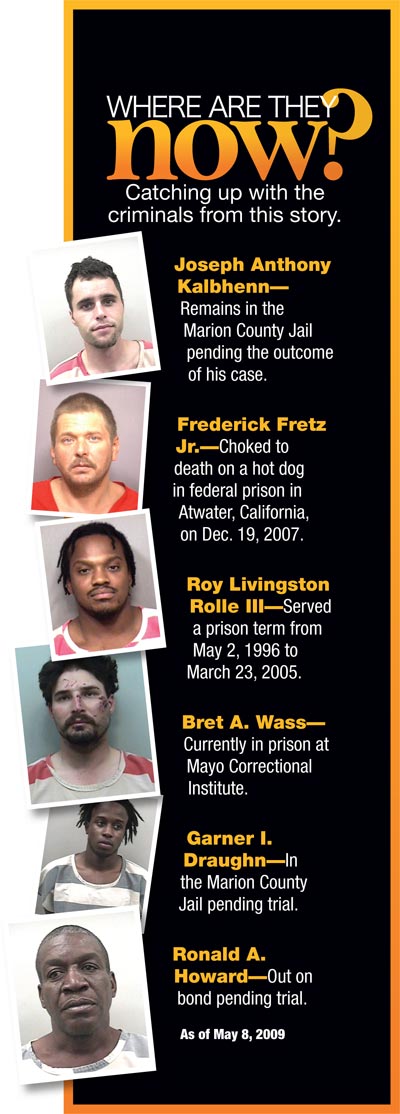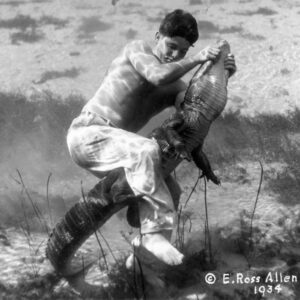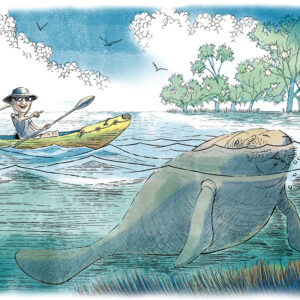
A 911 call sets into motion a complex network of first responders, from police officers and firefighters to paramedics. Their job is to protect, serve, and rescue you—often putting their own lives at risk to accomplish just that.
These are extraordinary individuals doing extraordinary things, day in and day out. Such are the demands of their professions that when they aren’t working, they’re training. They cannot afford to have an off day, not when a split-second decision can mean the difference between life and death. They work odd day-and-night shifts, ensuring that we’re taken care of 24/7. Meet six local men who are always at the ready.
Shoot Or Don’t Shoot
An impromptu off-duty decision makes for a pivotal moment in this OPD officer’s career.
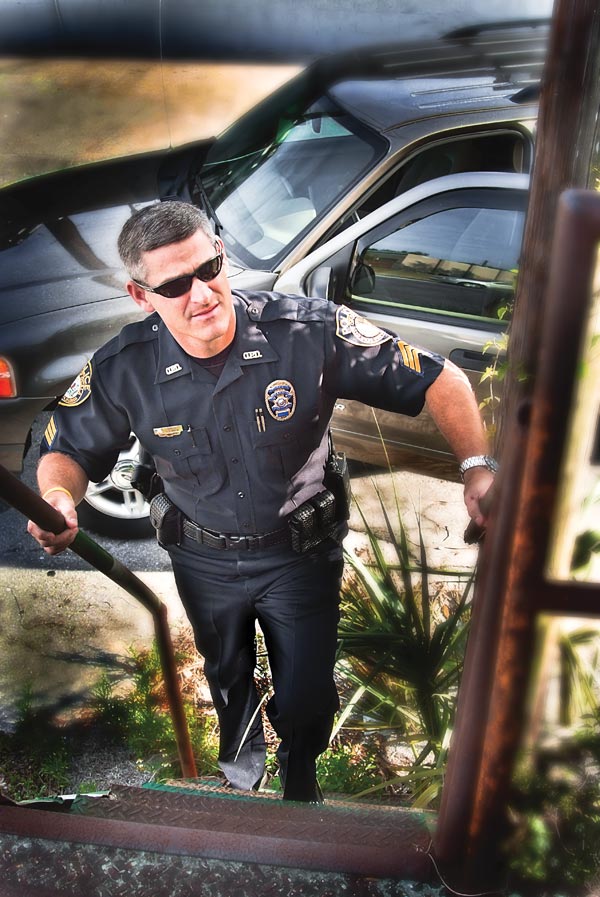
Sgt. Greg Martin
When the pharmacy robber, carrying a 9mm Mac 11 submachine gun, comes out into the parking lot, Ocala Police Sgt. Greg Martin, his own gun drawn, has an instant, life-changing decision to make. Shoot or don’t shoot.
The two men make eye contact, and Martin sees that the robber is surprised to see a cop already there. With the robber blocking his view into the pharmacy, not knowing if anyone could be caught in the crossfire, Martin makes his decision.
His gun aimed at the robber, Martin shouts, “Police! Drop your weapon!”
The robber turns and runs. And the chase is on. Down the street, across parking lots, and behind stores during 5 o’clock rush hour traffic.
While running, gun still drawn, Martin calls the dispatcher on his mobile radio: “I am in foot pursuit (breath) of an armed robbery suspect (breath) heading east off 17th Street (turn corner). He is wearing a brown T-shirt.” Then to the robber: “Drop your weapon or I’ll shoot!”
They make another turn, the robber stops, turns, makes eye contact again with Martin.
Temporarily paused and back in a shooting stance, Martin orders and warns again: “Drop your weapon or I’ll shoot!”
The robber drops the submachine gun to the ground, but again turns and runs. In a few strides, Martin overtakes him, wrestles him to the ground, and in seconds, the suspect is in handcuffs. Two people driving by in traffic pull over and ask Martin if he needs help. He waves them off as backup arrives.
For Martin, he was just doing his job—even if he was officially off-duty the afternoon of Thursday, February 19, 2009.
“I was driving home and thinking about going for a run at the park,” says Martin, 36, an Ocala Police Department officer for 13 years, the last 11 with the SWAT unit. “I was stopped at a red light when I heard the dispatch call of a robbery in progress at the 17th Street Discount Pharmacy. I look over and there’s the pharmacy. I drove right into the parking lot.”
Inside the pharmacy, Joseph Anthony Kalbhenn, 25, gun drawn and wearing a panty-hose mask and gloves, was demanding OxyContin and Percocet. He tells the employees that they have 45 seconds to comply or he’ll start shooting. When the pharmacist calmly talks to Kalbhenn, he momentarily lowers his gun and the pharmacist grabs it. The two men fall to the floor and there’s a brief struggle. Freeing himself from the pharmacist, who has managed to pull the panty-hose mask off his face, Kalbhenn runs out of the pharmacy into the parking lot and confronts Martin.
“Police officers are trained to assess a situation and make a decision in seconds,” says Martin, who in a word can be described as intense. “We have a tremendous amount of responsibility placed upon us to make life-changing decisions that ordinary people never have to make. We take that responsibility very seriously.”
For Martin, protecting innocent citizens and Kalbhenn not raising his weapon made him decide not to shoot.
“When we made that first eye contact, the training took over. Everything from there slowed down and seemed surreal,” he says. “If at that point or during the chase he’d raised his weapon, I would’ve had no choice but to shoot.”
Kalbhenn was arrested and charged with armed robbery, aggravated assault with a firearm, possession of a firearm during the commission of a felony, and resisting arrest without violence.
Martin finally made it home later to his wife, Challie, and their daughter, Riley, 9, and son, Austin, 5. Married for 11 years, Martin has learned it’s very important to “flip the switch” between being a cop and being a father and husband. He adds that he couldn’t do his job without Challie’s love and support.
As his children grow older, Martin knows they’ll ask him more questions about being a cop. He already has an answer.
“Yes, I like the action and the thrill of being a cop,” says Martin. “But it’s not about being a hero. My job is about catching bad people so they can’t hurt good people.”
Heart To Heart
Bringing patients back from the dead is just part of the job.
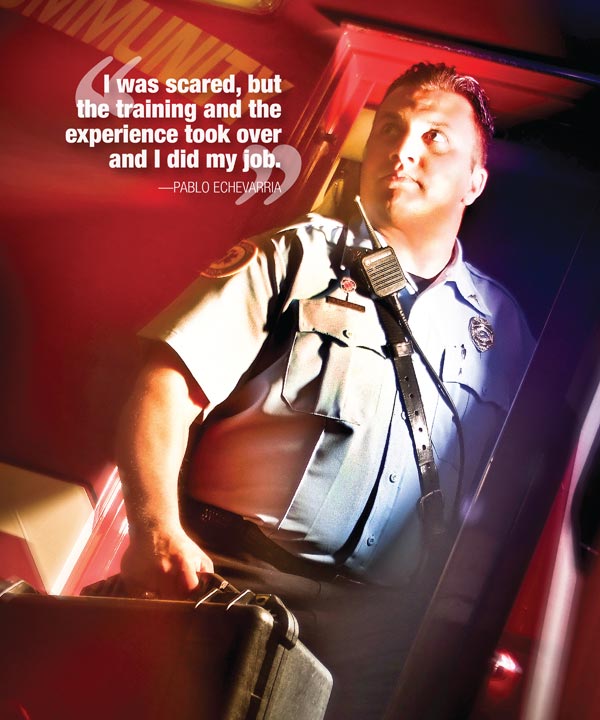
Sirens blaring and lights flashing, the Marion County Fire Rescue ambulance speeds toward Leesburg Regional Hospital. In the ambulance’s medical bay, firefighter/paramedic Pablo Echevarria knows 57-year-old Otto Zimmerman is having a major heart attack. He hopes he can keep him stabilized long enough to reach the hospital, 40 minutes away.
With firefighter/EMT and paramedic trainee Steve Spencer assisting him, Echevarria administers oxygen and the necessary medication to keep Zimmerman’s heart working. All the while, he watches the heart monitor screen. He doesn’t like what he sees and decides to take another step to slow down the heart attack.
“What are those for?” Zimmerman asks, fear in his eyes, as Echevarria attaches the defibrillator pads to his torso.
“Don’t worry. You’re doing fine,” Echevarria says calmly. “These are just a precaution. We’re almost at the hospital. You’ll be okay.”
Two minutes later, Zimmerman says, “I have a terrible headache. I think I’m going to pass out.”
Echevarria says, “It’s okay. It’s the medication we’re giving you that’s causing the headache…”
Zimmerman’s eyes roll back and he loses consciousness. He stops breathing and his heart stops beating, the monitor revealing a lethal heart rhythm. Zimmerman has died.
Immediately, Echevarria delivers a defibrillator shock, then to commands Spencer to “Start CPR!”
The heart monitor indicates a very slow heart rate, but Zimmerman still has no pulse.
“Continue CPR,” Echevarria instructs, watching the monitor as Zimmerman’s heart rate increases as he regains a pulse.
Thirty seconds later, Zimmerman opens his eyes. He’s literally come back from the dead.
Relieved but still cautious, Echevarria tells firefighter/EMT Matthew Dailey, who’s at the wheel, “Let’s divert to Waterman in Tavares. It’s closer and they can stabilize him there before he goes to Leesburg.”
After heart surgery to unclog an artery with 100-percent blockage, Zimmerman is released from Leesburg Regional a week later.
Fate had been on Zimmerman’s side the evening of March 18, 2009. When Zimmerman complained about pain in his chest that radiated up his left arm, his wife, Barbara, called 911. MCFR South Forest Station 6 firefighter/paramedics and firefighter/EMTs responded within five minutes. After confirming that Zimmerman was indeed having a heart attack, the crew provided advanced life support care, then called the MCFR Weirsdale Station 27 ambulance crew of Echevarria, Spencer, and Dailey.
The irony of the first life he saved as a firefighter/paramedic is not lost on Echevarria, who has his own heart story to tell.
“Many years ago while scuba diving, I suffered an embolism that damaged my heart,” says Echevarria, 33, who’d always wanted to become a firefighter. “I had to have a pacemaker. When that happened, I knew I could never become a firefighter.”
But Echevarria, whose mother is a nurse, decided to doggedly pursue a career in healthcare by becoming an emergency medical technician. For 10 years, he was an EMT with Lake County Emergency Medical Services. Then during an annual checkup, he received some unexpected good news.
“My doctor said that my heart had repaired itself,” Echevarria says, smiling even now about the news. “He said the battery had never worn out in the pacemaker because it was never used. With the doctor’s okay, I had the pacemaker removed.”
In December 2005, Echevarria applied to MCFR and was assigned as an EMT to Weirsdale Station 27. That was followed by dual certification as a firefighter/paramedic. A little over three years later, he and Otto Zimmerman had their heart-to-heart encounter.
“What happened with Mr. Zimmerman was amazing,” says Echevarria, a single father who keeps a photo of daughter, Alexis, 3, taped to the back of his badge. “I won’t lie. I was scared as it was happening, but the training and the experience took over and I did my job. Once it was over and we were at the hospital, I met the Zimmerman family. It was very emotional.”
Though Echevarria has never questioned his chosen profession, the Zimmerman experience deepened his devotion.
“No doubt about it,” he says, “this is my lifetime career.”
Eye In The Sky
This unique vantage point means that the bad guys are never really out of sight.
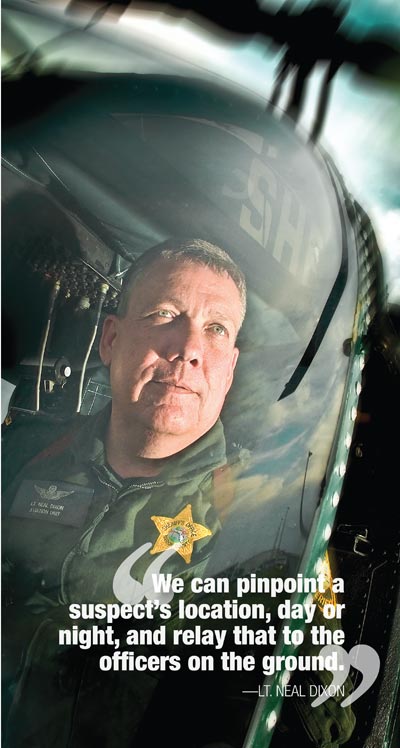
Note to criminals: You can run, but you can’t hide.
High above all the urban and rural ground clutter, Lt. Neal Dixon has his eyes on the bad guys. As the Marion County Sheriff’s Office’s aviation unit commander, Dixon has a perspective that has a distinct benefit for the good guys.
“We can pinpoint a suspect’s location, day or night, and relay that to the officers on the ground,” says Dixon, 44. “If we don’t have a direct eye visual on someone, our infrared cameras tell us where they are.”
The two MCSO Bell OH-58 military helicopters are equipped with infrared cameras, video downlink cameras, spotlights, and moving map computers. When the infrared camera picks up a human or an animal, the image shows up in pulsating bright green. To Dixon, the suspect might as well be holding up a neon “Here I am!” sign.
“Once we were tracking down a murder suspect at night in the Forest,” recalls Dixon, “and I was able to tell the ground searchers there was a bear nearby so they could avoid it. We finally spotted the suspect hiding up in a tree. Without the helicopter’s equipment, he could’ve very well escaped.”
During high-speed road chases, the helicopter is invaluable in keeping the suspect in sight and allowing the pursuing officers to chase at safer speeds. It is virtually impossible for a suspect, either in a vehicle or on foot, to elude a helicopter.
In January 2005, 11-year-old Dunnellon youngster Adam Kirkirt was kidnapped by convicted sex offender Frederick Fretz Jr. Four days later, Fretz’s broken-down car was spotted off an interstate exit ramp outside of Atlanta. Kirkirt was found wandering around nearby while Fretz had fled into the woods. As soon as the car had been spotted, Dixon flew immediately to the area. Surrounded by law enforcement, Fretz hid out in the woods. High above and throughout the night, Dixon kept the suspect in his sights until he was captured the next day.
“The boy was found safely and his kidnapper was caught,” says Dixon, whose law enforcement career also includes stints as a correction officer, patrol deputy, and property crimes detective. “That was a great day.”
The Dixon family has strong law enforcement ties. For 16 years, Dixon has been married to Sgt. Peggy Dixon, a Sheriff’s Office patrol supervisor. They met on the job. For daughters Megan, 14, and Taylor, 12, having parents as cops is all they’ve ever known.
“I took the helicopter to Megan’s school once as part of a Sheriff’s program,” Dixon remembers. “When I was done with the presentation, Megan walked over and asked for a dollar for a snack. As she walked off, I heard one of her friends question her why she asked me for a dollar. She shrugged and said, ‘Oh, that’s my dad.’ ”
Good As Gold
Being nearly killed by a vehicle—twice—hasn’t lessened this deputy’s resolve one bit.
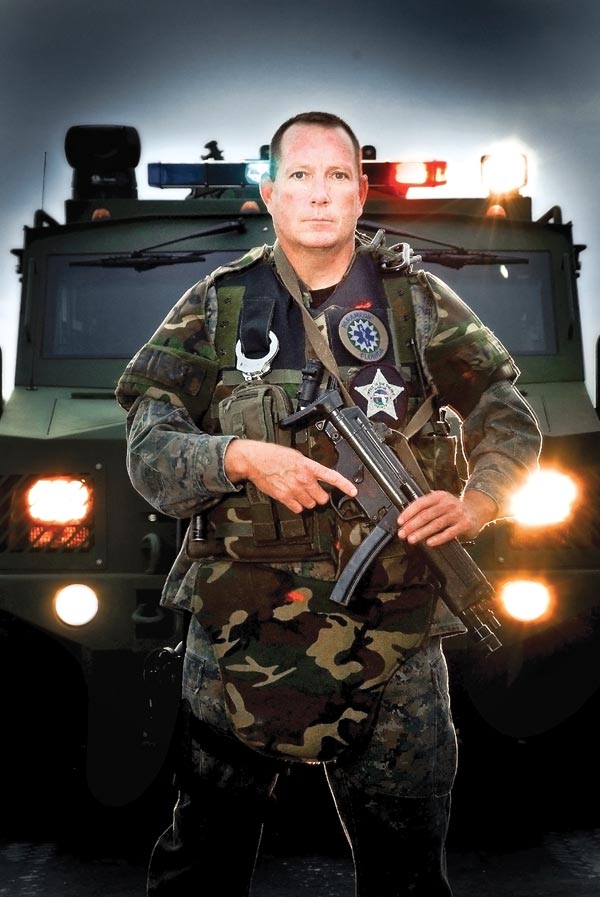
Sgt. Jeff Gold
Sgt. Jeff Gold should have “Street Cop” stamped across his forehead. Make that “Bionic Street Cop.” Not once, but twice, the Marion County Sheriff’s deputy has been run down by a vehicle while trying to make an arrest. He has the scars to prove it, too—a titanium rod reinforcing his right leg and metal pins holding his left hand together.
“The first time was in 1994. Along with two other deputies, we were trying to catch a rape suspect [Roy Livingston Rolle III],” says Gold, a poster cop for Type A personality. “We were out of our patrol cars, putting down stop sticks on the road when a car plowed into us. I ended up with two broken legs, a dislocated left arm, and a lot of other injuries. Once I recovered, it took a year of physical rehab before I could come back to active duty.”
But come back he did.
Gold has been a drug agent and drug unit supervisor; he is currently a patrol supervisor, bomb squad commander, as well as SWAT team medic and armored vehicle driver. He is also a dual-certified firefighter/paramedic and has a black belt in tae kwon do and a brown belt in jiu-jitsu. On the cerebral side, Gold has a bachelor’s in organizational studies, a master’s in criminal justice, and is working toward a doctorate in business management and public administration.
The second time? Gold was almost done in by a tow truck.
“Again, it was a rape suspect [Bret A. Wass],” says Gold, shaking his head at the coincidence. “I was on foot and searching a neighborhood for him. I heard an engine being revved up, turned, and saw this tow truck coming at me. The suspect was driving. We made eye contact and I knew he was going to run me over. I dove out of the way just in time, hit the road hard, and he wrecked the truck.”
Adrenaline pumping, Gold jumped up and chased down and captured the suspect, not realizing that his left hand had been shattered by the impact with the road. The hand is now essentially held together by pins, not able to be totally straightened out, but the additional metal hasn’t done anything to slow Gold down. In fact, he thinks he’s been lucky.
“I love my job,” says Gold, 43. “I can’t imagine doing anything else.”
Prior to becoming a patrol supervisor in 2005, Gold spent nine years in the drug unit. Now clean-shaven with a military-style haircut, Gold had a very different appearance while working undercover. Then he wore his hair long and straggly and had a goatee.
“I guess I just fit in real easy with the drug dealers,” Gold says. “I think they thought I was a little crazy, which in that world is not a bad thing.”
Actually, that very thing might have saved his life.
“Once, while in a drug dealer’s house out in the Forest, a group of us were watching TV, just hanging out,” recalls Gold. “This program comes on about cops and the dealers start bragging how they never had an undercover cop fool them. I happened to look down and saw my badge sticking out a little from my jeans’ pocket. Of course, I wasn’t supposed to have my badge with me. I remembered being in a hurry when I was changing from my uniform into my undercover clothes and, out of habit, I must have put my badge in my pocket.”
Nervous that the drug dealers might see the incriminating link to his real job, Gold seized the moment.
“I pull out my badge and say, ‘I’m a cop’,” Gold recalls. “They turned and looked at me, and it got real quiet—then they started laughing. They thought I had a fake badge and I was just kidding around with them.”
Staying undercover, Gold continued to do drug business with them for another month or so before they were arrested.
As much as he liked the adrenaline rush of the undercover drug work, Gold says he’s “happiest on the road.” And he doesn’t take the title of supervising sergeant to mean sitting behind a desk, managing others.
“I love being out on the streets on patrol, especially at night,” says Gold. “I like being where the action is. I still get that rush from catching the bad guys.”
During his off-duty time, Gold teaches an online college business course on his way to earning his doctorate. He also spends family time with his three daughters, Kailee, 14, Elizabeth, 12, and Peyton, 7.
“None of them want to be cops,” says Gold. “That’s okay with me.”
A Dynamic Duo
Being a K-9 cop means having a four-legged partner at your side 24/7. This OPD officer wouldn’t have it any other way.
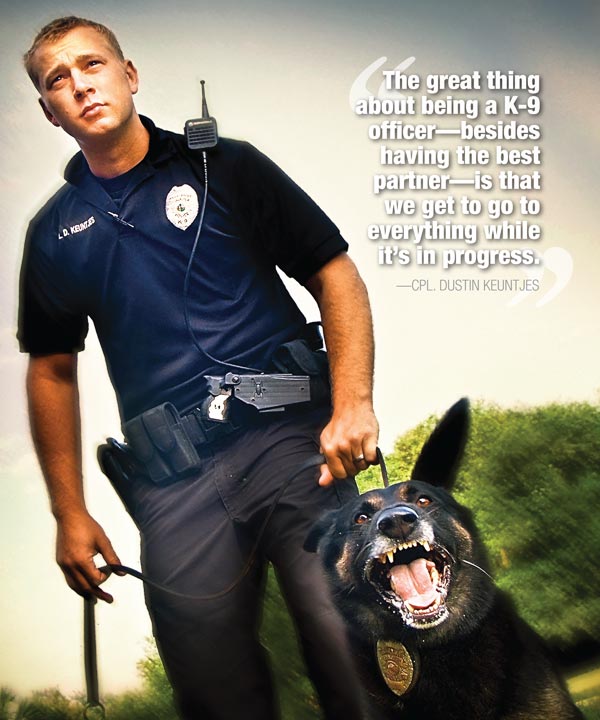
Ocala Police K-9 officer Corporal Dustin Keuntjes runs behind “Dozer,” his German shepherd partner, as the dog tracks the scent of two home invasion robbery suspects. Dozer dashes into an open metal shed and Keuntjes immediately hears growls and shouting. He knows Dozer has captured one of the suspects. In two strides, Keuntjes is in the shed, too. He sees a male suspect on the ground, wrestling with Dozer.
Keuntjes reaches down to grab the suspect and shouts, “Stop resisting and I’ll call off the dog!”
Kicking wildly, the suspect knocks Keuntjes down and now all three are in a struggle. Dozer is relentless, not releasing the bite he has on the suspect until given the order. Keuntjes manages to get some leverage and takes hold of the suspect’s arms.
“Off, Dozer!” Keuntjes commands as he yanks the man to his feet and reaches for his handcuffs.
Just as the dog obeys, the second suspect charges into the shed, slams into Keuntjes, and everyone is back on the ground. Dozer, trained to protect his partner, joins in the new fracas, biting and holding on to the second suspect. As the struggle continues, Keuntjes can hear police sirens and the sheriff’s helicopter flying over. But his mobile radio has been ripped off his shoulder and he can’t call in his location. He also realizes his fellow officers can’t see them in the shed. He and Dozer will have to get the situation under control on their own.
Wrestling with the first suspect, Keuntjes subdues him again and gets him in handcuffs while Dozer hangs on to the second suspect. With one suspect handcuffed, Keuntjes grabs his radio and alerts his backup that they’re in the shed. Then he takes hold of the second suspect, pins him to the ground, and gives Dozer the release command as help arrives.
Minutes later as Keuntjes and Dozer are walking away from the shed, a fellow officer points to his holstered gun. Keuntjes looks down—his weapon is hanging partially out of the holster, held in only by the safety strap. He takes a deep breath, realizing now that sometime during the struggle one of the suspects had grabbed his weapon and tried to pull it out of the holster. The consequences could’ve been deadly. But on this day, he and Dozer won the fight and are going home safely.
The two suspects went to jail. Garner I. Draughn and Ronald A. Howard had robbed and beaten a man twice because he was gay, which made it a hate crime. After they robbed and beat the victim the first time, they warned him not to call the police. When he did, they came back and repeated the crime. The pair was charged with home invasion robbery with evidencing prejudice while committing offense, attempted homicide, home invasion robbery with battery, and tampering with a victim. Howard was also charged with battery on a law enforcement officer.
“The great thing about being a K-9 officer—besides having the best partner—is that we get to go to everything while it’s in progress,” says Keuntjes (pronounced “Kenchess”), 27, a Wisconsin native filled with that Midwestern can-do attitude. “A K-9 police dog can do things and go places a person can’t. I can send Dozer into the deep woods, and he’s just going to barrel through to get to the suspect. If someone is hiding out in a building, I can send Dozer in and he’ll follow a scent trail and find someone quicker than we would doing a room-to-room search.”
In one recent case, a burglary suspect was hiding in a crawl space. Keuntjes and Dozer climbed up a ladder to the roof. Once at the top, Keuntjes, 6-feet-tall and fit, lifted Dozer up on his shoulders and put him into the crawl space. Within seconds, Dozer had secured the suspect and then Keuntjes and another officer followed him in. After a struggle with the suspect, who was high on drugs and had to be Tasered and pepper-sprayed, they pulled him out of the crawl space.
“Dozer loves his job even more than I do,” says Keuntjes, who has been with the Ocala Police Department for six years, half of that time with the K-9 unit. “He doesn’t have an ego, doesn’t worry about department politics, and is fearless. He’s always in a good mood and always happy to do his job.”
And when Keuntjes and Dozer go home at the end of a shift, both are off-duty. Keuntjes met his wife, Amanda, an Ocala native, when he would travel from his hometown of Green Bay to Florida to participate in motocross racing events. They have a 3-year-old daughter named Ava who loves to play with Dozer.
“He’s my partner,” says Keuntjes. “And part of the family.”
Rescue Me
Fighting fires means saving lives, whether of the two-legged or four-legged variety.
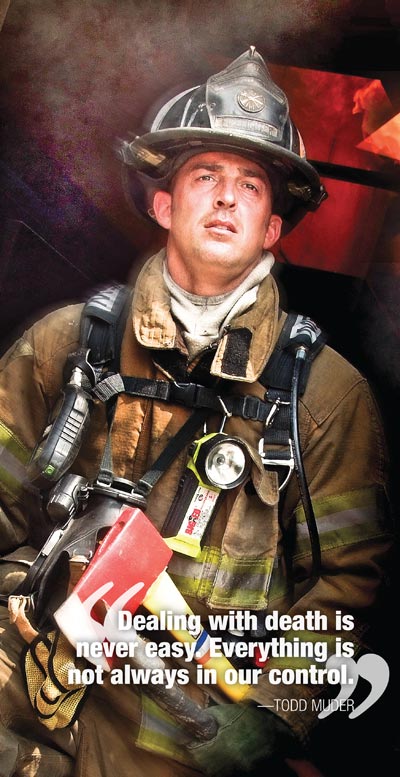
If by some unfortunate twist of fate you are in need of being rescued, you might have the good fortune to meet Todd Muder. The Marion County Fire Rescue firefighter/paramedic is a member of the North Central Florida Task Force 8 Search and Rescue Team. Stationed at Golden Ocala Station 20, Muder and his 17 colleagues, along with Ocala Fire Rescue, represent Marion County on the team that includes firefighters/paramedics from Alachua County and Gainesville fire and rescue operations.
“In addition to our standard fire and rescue operations, we’re also trained to do some out-of-the-ordinary rescues,” says Muder, 37. “We’re called for vehicle accident extraction, structural collapses, rope rescues, as well as natural and man-made disasters. I guess you could say we’re the specialty guys.”
Called to a recent accident on Highway 301, Muder and the unit arrived to find a semi-truck had flipped over on top of a car where a woman was pinned inside. Using special metal struts and inflated bags, the truck was stabilized, but was too heavy to be completely lifted off the car. Improvising, they started cutting a hole through the truck to try to reach her.
“We kept talking to her while we worked,” says Muder. “When we finally got through to her, we were able to pull her out. She was seriously injured, but we did hear later that she recovered. That was a win that day.”
Hanging on the wall inside Golden Ocala Station 20 is a grainy, black-and-white picture of Muder with another save. In his arms is a wide-eyed black-and-white shih tzu dog named Patches.
“We got to a house fire in Silver Springs Shores and it was about 50 percent engulfed in flames,” recalls Muder. “Our first priority is always to make sure there isn’t anyone trapped, so we went in to search. With the smoke, there is zero visibility, so we’re hugging the wall as we make our way into the kitchen. I put my hand down and something yelped. I reached down and picked up a little dog and got him outside. He was given oxygen and was just fine. When his owners arrived, they were very happy that Patches was okay.”
Muder has delivered two babies so far, one in a home and one in the ambulance, and he’s also experienced life’s ultimate foil.
“Dealing with death is never easy,” he says. “But we have a great support system here at the station. After we get back from a scene, we always decompress, and that’s the best way to deal with it. Everything is not always in our control.”
Being a firefighter is the only job Muder has ever wanted.
“I grew up in a little rural town in New Hampshire,” he says, grinning like a big kid. “We had a fire station and it had one fire truck, lime green, and when it sped down the street, sirens blaring and lights flashing, I just thought that was the best thing in the world.”
Soon after his parents moved to Ocala to escape the New Hampshire winters, Muder came for a visit, met his future wife, Lori, and also relocated. He was delighted to discover Ocala had a fire college. Now 16 years into his career, Muder describes what he does as “a calling,” one you “have to have a passion for.”
Besides the support he has at the fire station, Muder also has strong family ties as well. He and Lori have two daughters, Jessica, 14, and Alyssa, 9.
“The girls love coming to the fire station,” Muder reveals, “and telling people that Daddy is a firefighter.”
